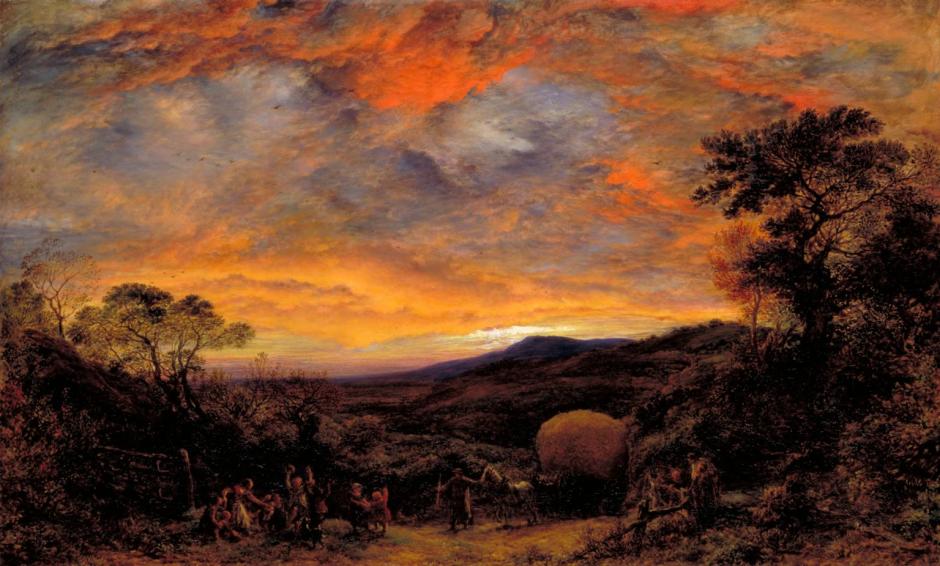In the first of these two articles looking at paintings of the rich golden countryside of England at harvest time, I showed some of the landscapes painted by Samuel Palmer when he lived in the rural village of Shoreham, in Kent, between 1826-1835. I resume today with some of the work of Palmer’s mentor and father-in-law John Linnell (1792–1882).
In 1851, Linnell moved his family from London to a house that he had built for them just outside Redhill, Surrey, where he spent the rest of his life. Living in the rolling North Downs, in the rich agricultural belt around London, provided him ample opportunity for the landscape painting which he so enjoyed, and which was now so well appreciated. Linnell also recognised the talent of the Pre-Raphaelites, and he gave Holman Hunt and Millais support and friendship from 1852 onwards.

Harvest Home, Sunset: The Last Load (1853) shows the final wagonload of cut grain leaving the fields at dusk, as the harvest is completed. Its composition and lighting could put it among the works of Samuel Palmer and the Ancients.

Like John Constable before him, Linnell’s oil sketches and studies have rich and expressive brushstrokes. If the chroma in his A Finished Study for ‘Reaping’ (1858) were turned up, it might easily be mistaken for an Impressionist work. However, it wasn’t intended for the eyes of the public, for which Linnell still provided Salon-quality finished paintings.

The Harvest Cradle (1859) is an ingenious rustic scene, where the children of those cutting wheat are tucked up in freshly-cut stooks.

Wheat (c 1860) was painted for the dealer Thomas Agnew, and was one of Linnell’s favourites. It was shown at the Royal Academy shortly after completion, then at the Exposition Universelle in Paris in 1867.
Samuel Palmer returned to harvest gold in his later years, although his attempts to recapture the magic of his time at Shoreham were seldom as intense, and some look tired.

Palmer’s Sunset (1861) is among the best of these, capturing the warm sunlight of the late summer, just before the grain harvest, with an overshot watermill and a small crag behind.

Tintern Abbey at Sunset (1861) rearranges the same rustic elements beside the ruins of Tintern Abbey, which had for more than a century attracted the best topographic artists in England.

A Dream in the Apennine (1864) must have been painted from sketches which he had made during his extended honeymoon in Italy. When he exhibited it in the same year, its note read: Suddenly, at a turn in the mountain road, we looked for the first time on that Plain; the dispenser of law, the refuge of philosophy, the cradle of faith. Ground which Virgil trod and Claude invested with supernatural beauty was sketched – but with a trembling pencil. It shows Rome in the distance, viewed from the south east.

Another of his late and more visionary paintings is the panoramic dusk view of Old England’s Sunday Evening (1874). Unusually, this takes us to coastal grain fields by a lonely church, as the local women and children are arriving for what must be a late service on a Sunday evening. Judging by its rocky and quite rugged coastline, this landscape cannot be in the south east of England, but looks to have been based on much earlier sketches made on the coast of Devon or Cornwall.
Harvest gold may have faded with the passing of Palmer and Linnell, who died within a year of one another in 1881-82, but it wasn’t done yet. In the early years of the twentieth century, Sir George Clausen returned to the theme.

Clausen’s The Gleaners Returning (1908) is a marvellous contre-jour (into the light) view, with swirling brushstrokes imparting movement in the women’s clothes, and more than a hint of that harvest gold.
May your harvest be gold as well this year.

